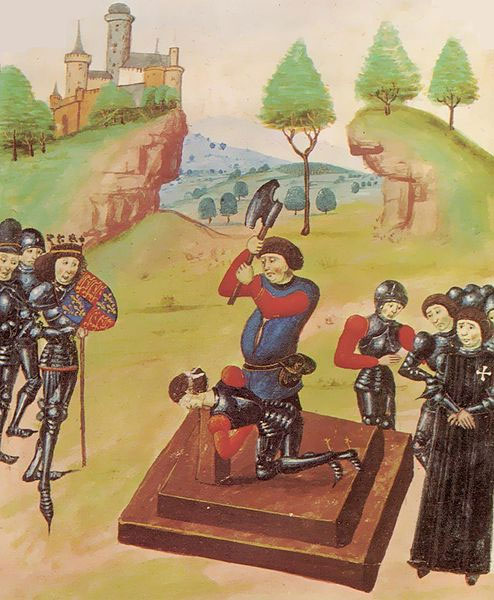The amazing truth about the head amputee is still 'life'.
The loss of the head is still alive and seemingly unreasonable and only a few cases occur in animals: cockroaches, snakes . But in human history, there have been some cases of losing most of the head, Headlessness still has signs of life.
Some later studies also hope to maintain a broken head for a long time to re-implant the body.

Artwork: internet
Miraculous cases like miracles
According to the newspaper Pravda (Russia), in 1888, the New York medical newsletter described an extremely surprising case of a sailor who was seriously injured while working on a tugboat in the river. While examining the crates of the boxes on the ship, which had been crossing the bridge, he was cut by a sharp sphere into a large piece of the skull, about 2 inches above his right eye.

An executioner is conducting a beheading.(Illustration)
But as a miracle, the sailor was still alive when he was taken to the hospital two hours later. Although the doctors diagnosed him, he would die at any time because he had lost one quarter of his head, but the victim opened his eyes to wake up after being bandaged with a wound. He lived for another 26 years and suffered a stroke only once.
In 1935, a child was taken to New York's St.Vincent Hospital in a state where there was no brain in his head . Although the whole brain is lacking, the child survived for 27 days, still having normal behaviors like eating, sleeping and crying like any other newborn baby. Until the autopsy was done, no one doubted anyone who did not have this brain.
Previously, according to Psychology, in September 1848, a worker named Phineas Gage, who was repairing a railway near Cavendish, Vermont, was suddenly exploded by an iron blast, causing an iron rod 109cm long and 3cm in diameter. through the left cheek, through the brain before falling to the ground 80 feet away.
The shocking thing was that the Gage was not only alive but also able to speak and walk until he was brought to the town to see a doctor. Edward H. Williams, the first therapist who met the Gage, was surprised.'First I noticed the wound on his head before I took out the tools from my luggage. At that time, I did not believe that the iron bar flew over Gage's head and the Gage still insisted that it was true. The Gage then stood up and vomited repeatedly, half of his brain fell on the floor, ' Williams told Psychology.

Phineas Gage goes into American medical history as the most difficult explanation.
By October 7, the Gage had started to travel and on October 11, his cognitive function began to improve. A few months after the Gage came back to live with his family, he became a case noted by American medical history as one of the most difficult cases to explain.'Phineas Gage's story is extremely memorable because it is an illustrative example that has changed the distance between folk legends and scientific legends,' said Malcolm Macmillan, an author who wrote about Gage's stories. to speak.
Elsewhere as a former Soviet officer Boris Luchkin in World War II, a reconnaissance teammate lost his head and only had his chin and lower jaw left. But his body was still standing, even Luchkin saw him unbuttoning his shirt and pulling out a bloody scout map until Luchkin took it, before falling.
Luchkin's story may be less popular by many people because he alone witnessed the incident. But before that in the history books, in 1636, King Ludwig of Bavaria (southern Germany) executed Dietz von Schaumburg and four co-founders suspected of winning the throne. By law, Dietz enjoys a request before he dies. Dietz pleaded with all the accomplices if after the amputation, Dietz still managed to walk 8 steps across all four. Ultimately Dietz was supposed to have done it and Ludwig had to keep his promise.
The chemist Antoine Lavoisier is one of the greatest scientists in France. Unfortunately, he lived in the bloody period of the French revolution. Unfortunately, he was a wealthy aristocrat. And even more unfortunate, he was an investor in a private tax collection company and collided with one of the leaders of the network - Jean-Paul Marat. All these unfortunate things have brought the famous scientist to the scaffold.
He was executed on May 8, 1794. However, Lavoisier was devoted to science until his last breath. He decided to participate in an experiment even when he died. He promised that after being beheaded, he would continue to blink until he was conscious and asked his friend to come to witness the incident. His friend did the right thing. Lavoisier's head was cut down and even blinked for 15 seconds before dying completely.
These strange stories seem to be only in ancient times, but according to science site Livescience, it has been reported that in recent years there have been reports of victims being left with signs. living strangely like blinking eyes, changing emotions on face, eyes looking and even trying to talk.
Which miracle or scientific basis?
In an attempt to find solutions to such strange cases, according to Pravda, some people like Professor Igor Blatov believed that humans have 'souls' besides cognitive parts . That soul is like a storage room for programs that maintain the functions of the body at any level from the activity of the nervous system to the various processes that take place in each cell. . Meanwhile the conscious part is only the result of the process of soul activity.

How long will a headless person live?(Illustration)
According to the latest research, every human body has 2 control systems.The first system consists of the brain and the nervous system , using nerve impulses to transmit information. The second system is based on endocrine glands . This system uses special biological substances or hormones to transfer information throughout the body. That partly explains why even when the brain is badly damaged, the body still has the signs and gestures of life.
Even in 2011, Dutch scientists used an EEG to study the heads of mice that had been removed from the body. The results showed that the severed electrical activity in the brain remained at normal frequency for a period of 4 seconds. Studies conducted in other small mammals have also shown that this happens even longer with about 29 seconds.
Previously, in 1905, Dr. Beaurieux had studied the criminal Henri Languille beheaded, showing that Languille still opened her eyes and called the executioner 's name twice in the period of 25-30 seconds. Although the time it takes for humans to live long after the first amputation is complete, there is still controversy, but just a few seconds is enough to have experiences that are no different from those of a living person.
While most scientists think that these expressions are the reflexes of the body for a short period of time , understanding a problem that seems impossible reveals a very important thing.
In 1954, when the scientist Vladimir Demikhov (Russia) introduced two-headed implants, he immediately created a race of surgical and implant techniques. The US government began funding for Dr. Robert White to carry out countless results of transplant experiments at the brain research center in Cleveland Ohio.
As a result, on March 14, 1970, Dr. White and his colleagues successfully implanted the head, which was cut off for a monkey with a new body. Although the monkey has been walking and surviving for only one day and at the same time dismissing the moral aspect of this problem, Dr. White's approach has created a new hope that someday this too Can be done to save human life.
- Infant's head: what mom should know!
- Does a true drug exist?
- 40 amazing, unexpected facts about the sun that you don't know (P1)
- Marvel at 8 incredible facts that seem like a myth
- Life is equally amazing between modern people and prehistoric people
- 8 facts about life make sure you don't know the many industry professionals reveal
- 11 interesting scientific facts
- What should you do when you hit your head hard?
- The facts about life may be unknown to you
- The amazing truth about the state of Texas in the United States is few
- Head implant - the conquest of pioneering anatomists
- Head transplants can take place in China
 'Fine laughs' - Scary and painful torture in ancient times
'Fine laughs' - Scary and painful torture in ancient times The sequence of numbers 142857 of the Egyptian pyramids is known as the strangest number in the world - Why?
The sequence of numbers 142857 of the Egyptian pyramids is known as the strangest number in the world - Why? History of the iron
History of the iron What is alum?
What is alum? The horror of the iron bar that pierced the skull gave birth to modern neuroscience
The horror of the iron bar that pierced the skull gave birth to modern neuroscience  Find the ego
Find the ego  The mystery in a person's brain is pierced through his head
The mystery in a person's brain is pierced through his head 